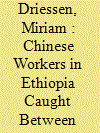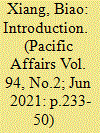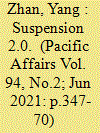|
|
|
Sort Order |
|
|
|
Items / Page
|
|
|
|
|
|
|
| Srl | Item |
| 1 |
ID:
178756


|
|
|
|
|
| Summary/Abstract |
Ever since Beijing has sought to fuel domestic growth through Chinese-led development overseas—first under the aegis of Jiang Zemin’s Going Out Policy and more recently as part of Xi Jinping’s Belt and Road Initiative—thousands of Chinese have moved overseas for work. Africa has been one of the destinations of Chinese companies and their expatriate staff. Although we have learned a great deal about China’s mega-projects across the African continent, little is known about the certified engineers and experienced builders who carry them out. What brings them to Africa? And, more importantly, what makes them stay for years on end, even if they wish to return to China? In this article I zoom in on the lives of Chinese men employed in Ethiopia’s construction industry to show how three decades of domestic growth in China has pushed workers overseas, while jeopardizing their return. Workers’ lives are marked by double displacement. They are not only isolated from local African communities through a dormitory labour regime that controls their time and limits their mobility, but also, more importantly, they are displaced from social life in China. Domestic development has at once increased aspirations and made them harder to obtain, especially for men, who are expected to fulfill the promise of upward social mobility for themselves and their families. In order to realize aspirations and meet social expectations related to social reproduction, geographic mobility has become a necessity for men who cannot rely on family wealth or connections, forcing them into a state of suspension.
|
|
|
|
|
|
|
|
|
|
|
|
|
|
|
|
| 2 |
ID:
178759


|
|
|
|
|
| Summary/Abstract |
This essay examines two films by the Chinese documentary filmmaker Wang Bing about temporary migrant workers in small, privately owned garment workshops in Zhejiang Province, China: Bitter Money (Ku Qian; 2016) and 15 Hours (Shi Wu Xiao Shi; 2017). Wang’s films portray Chinese garment workers’ lived experiences of “suspension,” as defined by Biao Xiang in this issue, in unique cinematic ways. Social sciences have paid close attention to the experiences of migrant workers, but art documentaries use audiovisual and aesthetic means to explore their everyday reality, producing what D. MacDougall calls distinctive “affective knowledge.” Wang’s films are usually categorized as part of the Sixth Generation of Chinese filmmakers, known for capturing social issues through observational methods. In this essay, I identify Wang’s works with the aesthetics of “slow cinema” and a global documentary trend in the visual arts as theorized by T. J. Demos in The Migrant Image. Based on close observation coupled with empathetic insight, Wang develops his own subjective method to portray people in a transformed and still changing China, where suspension is a common state of being. Ultimately, Wang’s films not only make the personal experiences of migrant workers visible and tangible, but also problematize their underlying, collective condition of suspension due to the contract labour system and associated hypermobility. The suspension approach suggests a productive way of bringing documentary art and social sciences into dialogue.
|
|
|
|
|
|
|
|
|
|
|
|
|
|
|
|
| 3 |
ID:
148709


|
|
|
|
|
| Summary/Abstract |
Low cost; easy to fabricate and flexible single wall carbon nanotubes thick film resistor (SWNT-TFR) for detailed study of NO2 detection is reported. SWNT-TFR was fabricated by vacuum filtration technique on flexible polycarbonate membrane. SWNT-TFR sensor shows selective response to NO2. The response increases from 1.47 per cent to 17.34 per cent with increasing the NO2 concentration from 0.2 ppm to 10 ppm, respectively. Different energy sources, IR, thermal and UV were explored for achieving fast recovery of the SWNT-TFR sensor. The results showed that the gas sensor gives immediate and fast recovery in the presence of UVC light. The calculated detection limit is less than 764 ppt for NO2. We are also presenting sensing of dimethyl methylphosphonate (DMMP) as a simulant of sarin. SWNT-TFR gives repeatable response of ~2.7 per cent for 500 ppm of DMMP. This work suggests the possibility to utilise SWNTs-TFR as NO2 sensors for air-quality monitoring.
|
|
|
|
|
|
|
|
|
|
|
|
|
|
|
|
| 4 |
ID:
178751


|
|
|
|
|
| Summary/Abstract |
“Suspension” is the translation of the Chinese term xuanfu, which has been widely used in public discussions in China since the mid-2010s. Suspension indicates a state of being in which people move frequently, conduct intensive labour, and pause routine life—in order to benefit fast and then quickly escape. People keep moving, with no end in sight, instead of changing their current conditions, of which they disapprove. As a result, frantic entrepreneurial energy coexists with political resignation. Suspension is a life strategy, a multitude of experiences, a feeling—and now, a keyword: a crystallized consciousness with which the public problematize their experiences. This special issue develops this term into an analytical approach based on ethnographic research involving labour migrants in and from China. This approach turns migration into a basis for critical analyses on issues far beyond it; enables co-research between researchers, migrants, and the broader public; and seeks to cultivate agency for change among actors. This introductory essay, based on the author’s long-term field research and public engagement, outlines why we need such an approach, and how we might develop it.
|
|
|
|
|
|
|
|
|
|
|
|
|
|
|
|
| 5 |
ID:
178757


|
|
|
|
|
| Summary/Abstract |
Since the late 2000s, many rural-to-urban migrants in China have lost their rural land to development plans, resettled in designated areas, and acquired formal urban residency. They stopped migrating, and have apparently ended their life of “suspension,” namely protracted mobility. While most existing research literature on this population foregrounds the issue of land dispossession, this article argues that, following resettlement, these former migrants’ lives can be more accurately characterized as a state of suspension instead of dispossession. Many resettled young adults, while having secured livelihood thanks to state compensation, are excluded from the technology- and capital-intensive developments to which they have lost their land. Some of these young people instead became petty speculators and rentier capitalists by liquidating their compensated assets through mortgages, private lending, rent, and other financial means. They are constantly waiting for the next investment opportunity and windfall gain. Although physically settled down and economically secure, they remain anxious and unsettled. They continue to orient their lives towards an elusive future rather than striving to transform the here and now, thus living in a state that I call “suspension 2.0.”
|
|
|
|
|
|
|
|
|
|
|
|
|
|
|
|
|
|
|
|
|